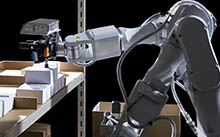Urban issues such as traffic congestion, energy consumption, and other various public challenges represent complex social problems due to a large number of interacting factors that must be considered. Quantum annealing machines are a promising new breakthrough technology with the potential to address such issues. Quantum annealing is a technology for efficiently solving a kind of problem known as "combinatorial optimization." In 2015, Hitachi developed a CMOS annealing machine as a new-concept computer that handles this task at high processing speed using semiconductor-integrated circuits. Hitachi’s CMOS annealing machine supports scalability, allowing expansion to large-scale systems in accordance with the scale of societal issues to which it will be applied. With the aim of practical implementation, basic research is being conducted at the Hitachi Hokkaido University Laboratory—an open laboratory established at Hokkaido University—with the concrete goal of applying CMOS annealing to societal issues within a few years.
Finding solutions to such issues as urban traffic congestion requires both a quantitative assessment of the characteristics of the elements that make up the problem as well as of their subtle interrelations. Specializing in solving problems known in the information processing field as "combinatorial optimization problems," quantum annealing machines have the potential to rapidly perform calculations for combinatorial optimization problems with a massive number of elements.
In 2015, Hitachi announced its CMOS annealing machine, a new-concept computer that is scalable to the sizes of elements required for solving societal issues. Employing a technique that differs from that of quantum computers, the CMOS annealing machine performs processing using semiconductor circuits, achieving both performance and energy saving that surpass that of conventional computers. When the parallelization of semiconductors became possible in 2018, it enabled further increases in processing speed.
In order to effect the social implementation of CMOS annealing machines, a process for supplying the relevant data of societal issues into CMOS annealing machines must be established. To accomplish this, it is important to develop software technology for mathematically expressing an actual phenomenon, i.e., a social issue, and converting this expression into a form that can be fed to an annealing machine. As a single company may not have the resources to easily solve the problem, this task called for collaboration with diverse fields. Among the most important of these were academic fields concerned with mathematical knowledge.

Professor Tamiki Komatsuzaki, director of Research Center of Mathematics for Social Creativity, Research Institute for Electronic Science, Hokkaido University
In 2016, Hitachi and Hokkaido University jointly established the Hitachi Hokkaido University Laboratory, whose purpose is to pursue research and industry-academia collaboration that seeks to find solutions for regional issues in Hokkaido. As one of its research themes, the laboratory conducts research aimed at the practical implementation of Hitachi’s CMOS annealing machine.
Professor Tamiki Komatsuzaki, director of the Research Center of Mathematics for Social Creativity, Research Institute for Electronic Science, Hokkaido University, who also serves as a representative in research on the practical implementation of CMOS annealing machines, summarizes industry-academia collaboration, as follows.
"The 'Mathematics for Social Creativity' part of the institute's name contains the idea of seeking to create a new form of mathematics that can potentially change our society. For example, just as the binary system and discrete mathematics are behind the birth of computers, social reform and mathematics are closely involved. Regarding industry-academia collaboration, I believe it is important to be able to conduct joint research with companies having a connection with society and to use research outcomes to create a new form of mathematics for changing society."
This new form of mathematics for changing society was precisely the knowledge from different fields needed for the practical implementation of CMOS annealing machines. However, the process for bringing together knowledge from different fields and producing new value is a challenging one. According to Professor Komatsuzaki, crucial to this is how to share problems and issues and, with a view toward such sharing, holding face-to-face discussions to the maximum extent possible.
Further elaborating, he states: "The current Hitachi Hokkaido University Laboratory has a system for easily sharing problems that is facilitated by having people involved in research stationed there. In fact, one assistant professor from Hokkaido University had the experience of actually working at Hitachi for about one year as a visiting senior researcher. This type of bi-directional exchange of personnel is very rare in industry-academia collaboration."
He also mentions that the present research is a richly meaningful activity for students and Hitachi Hokkaido University Laboratory members:
"Students have few opportunities to interact with actual societal issues, so they have little awareness of how mathematics can serve our society. In this respect, by serving as a place where people from various fields can gather, the Hitachi Hokkaido University Laboratory gives students a chance to learn about various societal issues and to gain an appreciation for the potential of mathematics. Conversely, when other mathematicians and senior professors are exposed to students' ideas, they too can acquire a new awareness of things."
The attitude of Hokkaido University, with its desire to create a new form of mathematics for changing society, and Hitachi’s Social Innovation Business resonate with each other. Resonation like this produces new values for both organizations and is a tremendous driving force for research.

Award ceremony for the programming contest, which had over 300 contestants
In the course of this research, the Hitachi Hokkaido University Laboratory first wanted to hear ideas from many people and therefore held a programming contest as part of a new initiative in 2017. This student-led contest went beyond organizational boundaries by soliciting a broad range of ideas from both Hokkaido University students and from people outside the university.
According to Professor Komatsuzaki: "The programming contest was planned by Hitachi members and the faculty of Hokkaido University who, with the cooperation of students from information sciences, developed contest problems that most people could easily understand. Thanks to this, we were blessed with the participation of a huge number of people."
Participants ranged in age from junior high school students to people in their 50s. Among these were students that came up with exceptional ideas, the outcome of which was the contrivance of an algorithm that is superior to conventional methods. Professor Komatsuzaki speaks of future issues and prospects, as follows:
"Our research project needs to gather as many ideas as possible relating to what can be done using CMOS annealing machines. In my view, universities and companies are limited in what they can do, so we need to go out into a wider range of the world to seek out such ideas through such events as programming contests."
In addition, Professor Komatsuzaki points out that, to stimulate collaboration between different fields, the Hitachi Hokkaido University Laboratory takes an active approach in getting the participation of people from various fields, stating that:
"The Hitachi Hokkaido University Laboratory brings in several new people a year as members from the university. These have included, for example, a lecturer from the department of chemistry and a health sciences researcher who we asked about the feasibility of applying CMOS annealing machines to chemistry or to medical fields."
This approach has enabled connections to develop not only with mathematics, but also with diverse fields from information sciences to chemistry and medical fields, resulting in the expansion of a joint research circle throughout Hokkaido University and making it possible to explore new potential for CMOS annealing machines. This, too, is an outcome for which the present joint research project deserves credit.


The highly miniaturized, business card-size CMOS annealing machine features high-speed calculation performance about 20,000 times faster and an energy efficiency about 170,000 times greater than conventional computers.*
*Comparison results were obtained by using a general-use CPU (Intel Corei7-6700K, 4.00 GHz) to perform annealing calculations under the same conditions as the CMOS annealing machine; energy efficiency is defined as (No. of parameters / Calculation time) / Power consumption.
In February 2019, Hitachi announced a CMOS annealing machine designed in the size of a business card. With further miniaturization expected in the future, this represents a new technology that is envisioned for embedding into IoT devices such as smartphones, cameras, and sensors for performing in-device data processing.
As technological innovations like this progress, and the implementation of IoT in many aspects of our lives accelerates, new needs are expected to be generated in the area of finding solutions to heretofore challenging societal issues, in industry, and in other potential applications.
Collaboration with different fields is essential toward fully exploiting the performance of CMOS annealing machines. Targeting the social implementation of CMOS annealing machines within a few years, Hitachi will continue to strengthen its collaboration with Hokkaido University and will actively incorporate knowledge from various fields.
Release Date: March 2019
Solutions By: Research & Development Group, Hitachi, Ltd.







